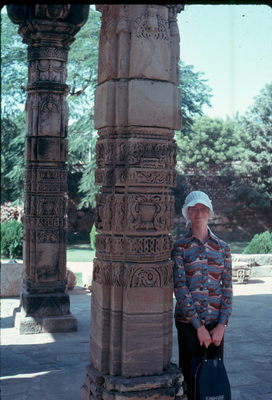 =0=
=0= =0=
=0= =0=
=0= =0=
=0= =0=
=0= =0=
=0= =0=
=0= =0=
=0= =0=
=0= =0=
=0= =0=
=0= =0=
=0= =0=
=0= =0=
=0= =0=
=0= =0=
=0= =0=
=0= =0=
=0= =0=
=0= |
 =0=
=0= |
| Above on the left is a mausoleum that we saw just on the side road. It wasn't on maps or broushures, but throughout the Delhi / Agra area there were numerous mausoleums. This was a more ordinary one and not in such good repair. Next to that is a picture of a relatively new Buddhist temple. This picture is of the front of this temple. In India whenever we visited a mausoleum or temple we would be expected to take off our shoes and in would normally be before you enter the main area (so this would be a shoe's off area). There would be an open area where the Indian's took off their shoes and just left them and an area off to the side where Westerners could take off there shoes and there would be a person who watched over them. They didn't seem to expect tips which we were glad of. In Korea and Taiwan everyone would just leave their shoes in a common area and there didn't seem to be any problems. In Japan, Hong Kong, and Thailand, for Westerners there would be a special area with little shoe boxes (and sometimes even claim checks), but on the way out they would often ask for a donation. Sometimes we would make a donation and sometimes not as we really didn't think that our shoes needed any protection. They were two dollar tennis shoes from Korea and certainly not worth stealing. |  =0=
=0= |
 =0=
=0= |
 =0=
=0= |
| Above are two more pictures from that Buddhist temple. The one on the left is the dome of that temple and the one on the right has the inverted swastika. Beneath that there was an explanation that the symbol pre-dated Buddhism and stands for karma, eternal peace in heaven and harmony. Of course in Korea the inverted swatika was on most of the temples we saw. This picture is one of the many carved marble panels that decorated the walls around the temple. |  =0=
=0= |
| This picture is from an older section of the area with Barbara standing next to some quite old decorated columns. Below on the left was a large artifice that intrigued us. It is hollow with three windows. We expect that it is a really old mausoleum, but that was only a guess. In that area there were many old arches and such as you can see in the picture below on the right. That was of an old mausoleum as the casket is there though the roof is gone. We learned that there is normally a decorative casket at floor level and that underneath it there would be the real casket (same size and shape, but underground and not generally open to the public. |  =0=
=0= |
 =0=
=0= |
 =0=
=0= |
 =0=
=0= |
 =0=
=0= |
| Above on the left is a picture of a woman in her sari with her son. Next to that is an arch that particularly impressed us. From there we were off to the zoo. The Delhi zoo is right next to an old fort which is shown here. Below on the left is a picture of the old walls which were a couple of feet think and two or three stories high. Also, it appears that the original fort was quite large, enclosing a couple of acres at least. Next to that is a picture of a couple of elephants in the zoo staying in their shelter and out of the heat. We really liked the zoo in Delhi as most the enclosures were large and lent a more natural setting for the animals. We noticed that Indians had a much more accepting attitude toward animals. For example, on the night that we stayed with Mr. Ramesh, in the morning we were having tea and couple of lizards would scamper along the wall and he would take no notice, commenting, 'Oh they are good, they eat the bugs'. Later the door would be left open and birds would fly into the room and no one took any particular notice. |  =0=
=0= |
 =0=
=0= |
 =0=
=0= |
| I seem to have lost the commentary on these last few pictures so you will have to decide on your own what the significance is. |  =0=
=0= |
 =0=
=0= |
 =0=
=0= |
| My recollection may not be very good, but I bet this is a rhinocerous. |  =0=
=0= |
This page was last updated on May 4, 2006.